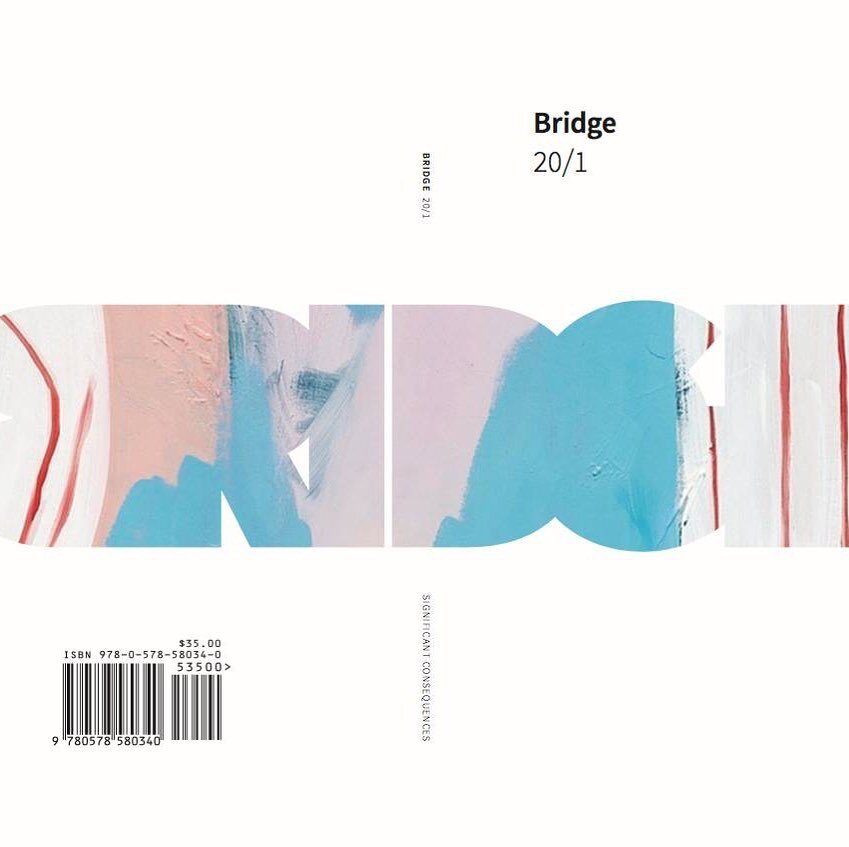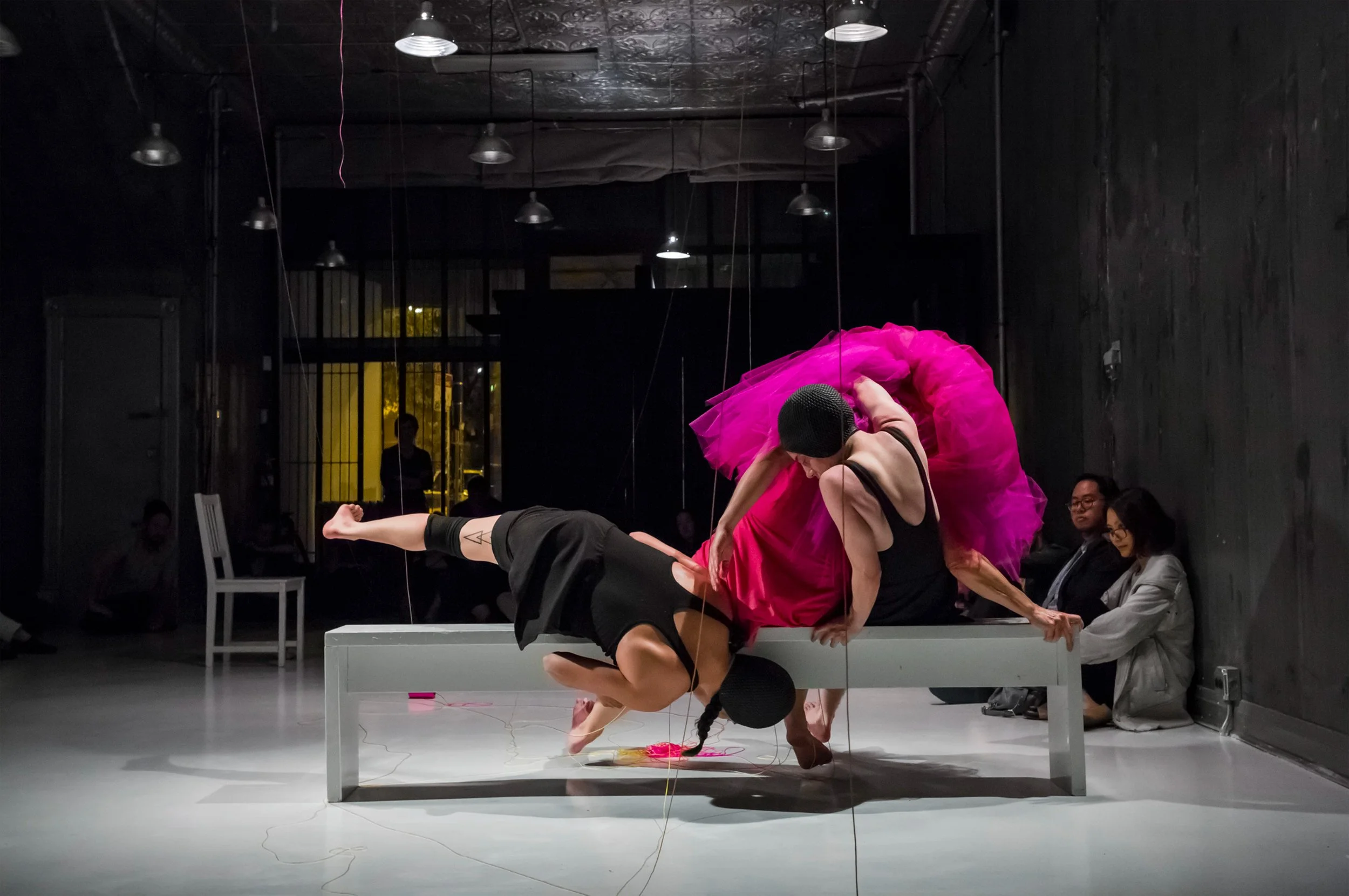The Balance In-Between, Michelle Kranicke, 2014. Choreographic architecture, performance installation. Image courtesy the artist and Defibrillator Gallery.
Bridge Presents: Choreographic Place at the Evanston Art Center
Choreographic Place is an exhibition program presented by Bridge premiering at the Evanston Art Center February 20–March 14, 2026 that explores the evolving relationships between dance, sculpture, movement, written choreography, and civic space through the framework of choreographic objects. Long a subject of inquiry in the dance community—most notably articulated by choreographer William Forsythe—in his notion of "choreographic objects," Bridge collective members Michelle Kranicke, David Sundry and Michael Workman seek to expand the definition to architectural or sculptural forms designed not simply to occupy space, but to shape how bodies move and behaviors may be regulated within it, how choreography is written and read, and how movement is negotiated collectively in shared environments.
Developed in collaboration with sculptor David Sundry and Zephyr Dance, Choreographic Place positions the large-scale sculptural forms of Sundry's sculptural dance set pieces as both standalone artworks and active performance environments that prompt, constrain, and inspire new ways of moving. Over the past two decades, Sundry, working closely with Zephyr founder Michelle Kranicke, has produced a series of architectural-scale constructions that restrict, restrain, and otherwise challenge the body’s navigation through space. These objects, often mistaken for stage sets, are in fact sculptural installations whose full meaning emerges only through interaction with performers, choreographers, and audiences alike.
The exhibition will showcase the breadth of Sundry’s practice—presenting these works as visually compelling art objects while tracing their development as collaborators in choreographic creation. It will include 2D architectural drawings, process materials, documentation, and written choreography authored by Michael Workman, presented as instructional text that guides and challenges visitors in how to negotiate the environments themselves. It will also feature restaged and newly developed dance works by Zephyr, associated artists, and partner companies. Conceived as both a choreographic and civic research platform, Choreographic Place will serve as a site for structured experiments in which dancers, musicians, writers, and the public explore how spatial constraints, sculptural interventions, and textual prompts can generate new improvisational vocabularies and shared embodied experiences.
It also launches Instructions for Living, a folio of performance scores by Workman with this section created in dialogue with Kranicke and Sundry, serving as both archive and public tool for movement-based exploration.
Artist Bios:
Michelle Kranicke is the artistic director of Zephyr, the experimental dance company she founded in 1990, and co-director of SITE/less performance space. She has received a number of awards and commissions for her choreography, her curatorial practice, and Zephyr performance projects including, artist residencies at Djerassi Artist Ranch, Woodside, CA and Yaddo, Saratoga Springs, NY, a commission by the City of Chicago Department of Cultural Affairs and Special Events, an artist residency at Defibrillator Gallery, Chicago, an artistic associate and curatorial resident award from Links Hall, Chicago, and a Chicago Dancemakers Forum Lab Artist Award. In 2019 she was named one of Chicago’s 50 Players in New City. In 2017 she was named one of Chicago’s Top 5 Choreographers and her 2016 aMID Festival was named Best Dance Festival. Michelle’s work has been presented locally and nationally by Defibrillator Gallery, The Dance Center of Columbia College, The Department of Cultural Affairs and Special Events, The Museum of Contemporary Art, Chicago; 9x22 Dance Lab, Minneapolis, MN; Triskelion Arts, Brooklyn, NY; Mulberry Street Theatre, Cunningham Dance Studio, New York; The Art & Culture Center of Hollywood, Hollywood, FL; North Dakota State University, Fargo, ND; Margaret H’Doubler Theatre, Madison, WI; and more. Michelle’s writing has been published in the Journal for Dance Education and Bridge. For 10 years she was adjunct faculty at Illinois Wesleyan University and has taught at The Dance Center of Columbia College and Columbia College’s Center for Community Arts Partnerships.
David Sundry is a licensed architect and builder constructing single-family homes, small offices, and mixed-use spaces in Chicago. He is the founder and president of Triple O Construction, a small design/build construction company, and O Group, Inc., its partnering architecture studio in association with Lyle Haag Engineering. His buildings have been featured in The Wall Street Journal, Chicago Magazine, Chicago Social, and Better Homes and Gardens. Most recently, his renovation of an historic 1951 convent designed by Belli & Belli was part of the exhibition Outside the Box: Modern and Contemporary Houses presented at the Riverside Arts Center. Sundry is co-director of SITE/less performance space and creates site-specific small to large-scale architectural environments and installations for performance. Recent installations at SITE/less include, a primary and tertiary colored platform and a ceiling sculpture fabricated from wood trusses, metal studs and fluorescent lights designed for a contemporary re-staging of Merce Cunningham’s 1958 work, Suite for Five, a series of greenscreen stacked runways for performance and live-mix video projection, a hanging disk fabricated from shipping palettes, and viewing platforms for the screendance festival Video Corpo. Additional commissions include an experimental music and performative sound sculpture installation at Augustana Lutheran Church for NON:op Open Opera Works and a steel fabricated information kiosk in Perez Plaza for Bridge, NFP.
Michael Workman is an artist, writer, reporter, and sociocultural critic, whose bylines have appeared in the Chicago Tribune, Guardian US, Newcity magazine, WBEZ Chicago Public Radio, and many other national and international publications. He is the former Chicago correspondent for renowned Italian art magazine Flash Art. Workman is also Publisher and Editor-in-Chief of Bridge (bridge-chicago.org), a Chicago-based 501 (c) (3) publishing and programming organization since 1999.
Workman is also Development Officer of the Kyiv-Mohyla Foundation of America and the Development Coordinator of the Ukrainian Institute of Modern Art (UIMA). His grant writing work has won several prestigious recognitions, including the Wynn-Kramarsky Freedom of Artistic Expression award from the Andy Warhol Foundation for the Visual Arts on behalf of UIMA and, in 2024, he wrote the proposal that resulted in the recognition of Ukrainian Village as a state-designated cultural district.
His choreographic writing has been included in Propositional Attitudes, an "anthology of recent performance scores, directions and instructions" published by Golden Spike Press, and his Perfect Worlds: Artistic Forms & Social Imaginaries, the first in a 3-volume series, was released by StepSister Press in October 2018 with a day-long program of performances at the Museum of Contemporary Art, Chicago.
Most recently, in 2023 he presented Active Investigation, a performance combining restructured texts, place, literary history and phonemic poetics at the Neubauer Collegium at the University of Chicago. He is a 2025 Illinois Arts Council Creative Projects grant and Rabkin Foundation travel grant recipient, and the Fall 2025 Joan and Peter Hood Artist-in-Residence at the Allerton Park & Retreat Center in Monticello, Illinois. michaelworkmanstudio.com
This exhibition and publication is supported in part by a grant from the Evanston Arts Council, the Hyde Park Art Center Artists Run Fund, grants from the Illinois Arts Council, including the 2025 Creative Projects awards, and the National Endowment for the Arts.


